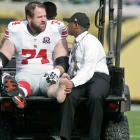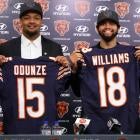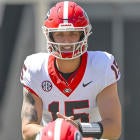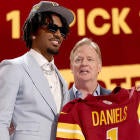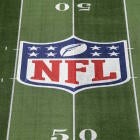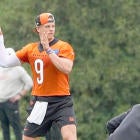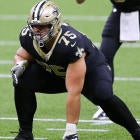
There are many people who believe the game of football is dying. Whenever there's a less-than-perfect game on prime time television, everyone laments the lack of good play. Every time someone retires before the age of 30, there's a new freakout about whether or not football can survive.
Spoiler: it can! And current NFL lineman Geoff Schwartz, in a Monday Morning QB column for TheMMQB.com, explains why the game is different but not dying.
I think I'm tired of people attacking the NFL game. Yes, it's different than years ago, but it's not dying and it's not a worse product. Just look at how much money the NFL is making. If you want to find a factor that changed the game the most, look at two-a-day practices going away. Two-a-days is a phrase that makes all footballers cringe. The current CBA, under the premise of player safety, did away with two practices a day. But that decision dramatically changed the game. Blocking and tackling will never be the same without two-a-days. Those are skills that need constant repetitions. I used to blame collegiate spread offenses for the general decline of O-line play but the loss of reps is mostly at fault.
This was the give-and-take from the new Collective Bargaining Agreement. Less offseason work for the players meant players staying healthier in the offseason, but it also meant players getting less reps with their teams. As players change teams, it becomes increasingly difficult to acclimate to new systems (this is also something Schwartz talked about -- the whole column is very well done and worth a read). Football is also hard to play.
Another great point Schwartz makes is about players being injury prone. Or at least labeled injury prone. When someone doesn't play a full season on a regular basis, we frequently point out how they're not able to stay healthy. That largely ignores the fluky nature of injuries plus, again, how hard football is to play and the difficult toll it takes on your body.
Schwartz has dealt with a lot of injuries in his career and actually admits to being an "injury-prone journeyman."
As hard as it is for me to say, I'm a journeyman who's been prone to injury. Yet here I am, on my fifth team entering my ninth season, having gone through six surgeries, a severely dislocated toe and badly injured groin. How does a late seventh-round pick make it this far with an injury list like mine? I beat the odds. Why? I'll lay it out in a bit. But first I want to take a few shots at the label "injury-prone journeyman."
Challenging the toughness of a football player is the worst insult we can receive. This game is tough, physically and mentally. The tag "injury-prone" has a connotation of softness, even if it's not meant that way when said or written. I hate this label. Injuries are not created equal. There's no way to prepare your body for guys falling on your legs. Or your big toe dislocating while trying to anchor a bull rush. S--- happens. I feel awful about not being reliable. I pride myself on showing up prepared to work everyday. If I could have done something different to prevent these injuries, you can bet I would have. But there was nothing to be done.
There's also a link to an image of an actually dislocated toe in the story -- you can get there on your own.
But the larger point here from Schwartz is that it's insulting to rip someone who is tough enough to actually play football by calling them injury prone. It's a fair point: if you're able to make it to the NFL in the first place, you're probably not injury prone.
As the Lions lineman points out, he started 19-straight games for the Chiefs previously (which led him to score a huge free-agency deal with the Giants). And he was also part of the record-breaking run by Jonathan Stewart and DeAngelo Williams when the pair of Panthers backs both went over 1,000 rushing yards in a season back in 2009.
Schwartz then goes on to detail how he's survived, with an interesting point about the lower half of the average NFL roster. Short version: the gap between players on the back end of NFL rosters is a lot closer than most people probably think. What separates them is how they work and train and approach the game.
Again: it's a fascinating read and well worth your time, particularly when lots of people are spending the summer relaxing by a pool, sitting on a beach or hanging out with friends and talking about how not-so-tough or injury prone their team's latest free-agency signing is.
Oh yeah: and football is probably doing OK, too.













